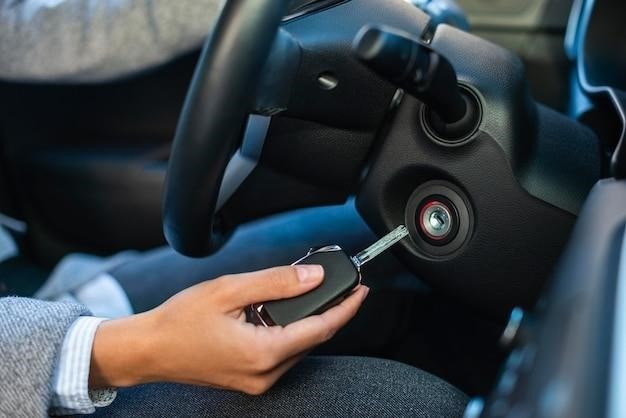Auto Start-Stop⁚ A Guide to the “Manual Restart Required” Message
The “Auto StartStop Manual Restart Required” message appears on your vehicle’s display when the auto start-stop system is not functioning properly and the engine needs to be restarted manually. This message can be frustrating‚ but it’s important to understand why it occurs and how to address it. This guide will help you navigate the common causes‚ troubleshooting steps‚ and solutions for this issue.
What is Auto Start-Stop?
Auto start-stop‚ also known as engine stop-start or idle-stop‚ is a fuel-saving technology that automatically shuts off the engine when the vehicle comes to a stop‚ such as at a traffic light or in heavy traffic. When the driver releases the brake pedal or depresses the clutch (in manual transmission vehicles)‚ the engine automatically restarts. This technology aims to reduce fuel consumption and emissions by eliminating unnecessary idling.
The system relies on a combination of sensors and actuators to determine when to shut down the engine. These sensors monitor factors like vehicle speed‚ engine temperature‚ battery charge level‚ and brake pedal position. When the conditions are right‚ the engine shuts off‚ and the vehicle’s electrical systems are powered by the battery. When the driver signals the intention to move again‚ the engine restarts quickly and seamlessly.
Auto start-stop is becoming increasingly common in modern vehicles‚ particularly in gasoline-powered cars and hybrid electric vehicles. While it’s designed to be a beneficial feature‚ it can sometimes malfunction‚ leading to the dreaded “Manual Restart Required” message.
Why Does the “Manual Restart Required” Message Appear?
The “Manual Restart Required” message signals that the auto start-stop system is not functioning as intended and the engine needs to be manually restarted. This message can appear for a variety of reasons‚ and understanding the potential causes can help you troubleshoot the issue; Here are some of the most common reasons why you might see this message⁚
Battery Issues⁚ The auto start-stop system relies on the battery to power the vehicle’s electrical systems while the engine is off. If the battery is weak or has a low charge‚ the system may not be able to restart the engine properly.
Temperature Extremes⁚ Extreme temperatures‚ both hot and cold‚ can affect the auto start-stop system’s functionality. The system may not function correctly in extremely cold weather because the battery’s performance is compromised in cold temperatures. Similarly‚ in extremely hot weather‚ the system may shut off due to excessive heat‚ preventing the engine from restarting.
Engine Malfunction⁚ Sometimes‚ the issue lies with the engine itself. If the engine is having trouble starting or running smoothly‚ the auto start-stop system may not be able to restart the engine‚ leading to the error message.
System Glitch⁚ Like any complex system‚ the auto start-stop system can occasionally experience software glitches or malfunctions. These glitches can prevent the system from functioning correctly‚ leading to the “Manual Restart Required” message;
Understanding the potential causes of the “Manual Restart Required” message can help you narrow down the problem and take appropriate steps to address it.
Common Causes of Auto Start-Stop Malfunction
While the auto start-stop system is generally reliable‚ malfunctions can occur. Understanding the common causes can help you troubleshoot issues and potentially avoid unnecessary repairs. Here are some of the most frequent reasons behind auto start-stop problems⁚
- Battery Issues⁚ A weak or failing battery is a common culprit behind auto start-stop problems. The system relies on the battery to power the vehicle’s electrical systems while the engine is off and to restart the engine when needed. If the battery can’t provide enough power‚ the system may not be able to restart the engine‚ leading to the “Manual Restart Required” message.
- Faulty Starter⁚ The starter is responsible for cranking the engine to start it. A faulty starter can prevent the engine from restarting properly‚ leading to auto start-stop malfunctions. This can be due to a worn starter motor‚ a faulty starter solenoid‚ or issues with the starter wiring.
- Sensor Problems⁚ The auto start-stop system relies on various sensors to monitor the vehicle’s conditions and determine when it’s safe to shut off and restart the engine. Problems with these sensors‚ such as the crankshaft position sensor‚ the camshaft position sensor‚ or the battery voltage sensor‚ can disrupt the system’s operation.
- Software Glitch⁚ Like any complex system‚ the auto start-stop system can experience software glitches or malfunctions. These glitches can prevent the system from functioning correctly‚ leading to the “Manual Restart Required” message.
- Environmental Factors⁚ Extreme temperatures can affect the auto start-stop system’s functionality. In extremely cold weather‚ the battery’s performance is compromised‚ making it harder to restart the engine. Similarly‚ in extremely hot weather‚ the system may shut off due to excessive heat‚ preventing the engine from restarting.
If you’re experiencing auto start-stop problems‚ it’s important to diagnose the issue to determine the root cause and take appropriate action. A qualified mechanic can help pinpoint the problem and recommend the necessary repairs.

Troubleshooting Steps for Auto Start-Stop Issues
Before rushing to a mechanic‚ you can try some basic troubleshooting steps at home to potentially resolve the “Auto Start-Stop Manual Restart Required” message. These steps can help identify and address simple issues that might be causing the malfunction.
- Check the Battery⁚ Start by checking the battery’s condition. Ensure the battery terminals are clean and securely connected. You can also use a multimeter to measure the battery’s voltage. A low battery voltage can prevent the auto start-stop system from restarting the engine. If the battery is old or has a low charge‚ consider replacing it.
- Reset the Auto Start-Stop System⁚ In some cases‚ a simple reset can resolve the issue. Disconnect the battery cables for a few minutes (at least 10 minutes) to allow the system to reset. Reconnect the cables and try restarting the engine to see if the “Manual Restart Required” message has disappeared.
- Check the Fuse⁚ The auto start-stop system is controlled by a fuse. Consult your vehicle’s owner’s manual to locate the fuse responsible for the auto start-stop system. Inspect the fuse for any signs of damage or a blown fuse. Replace the fuse if necessary. The fuse diagram in the owner’s manual will show you the fuse location for the auto start-stop system.
- Check the Engine Oil Level⁚ Low engine oil levels can affect the auto start-stop system. Ensure the engine oil level is within the recommended range. Check the oil level using the dipstick and add oil if needed.
- Inspect the Starter⁚ If the starter is malfunctioning‚ it might prevent the engine from restarting. While this is a more complex issue‚ you can try inspecting the starter for signs of damage or wear. If you notice any issues‚ consult a mechanic.
If these troubleshooting steps don’t resolve the issue‚ you’ll likely need to take your vehicle to a qualified mechanic for further diagnosis and repair. They can use specialized diagnostic tools to identify the root cause of the auto start-stop malfunction and recommend the necessary solutions.
How to Manually Restart the Engine
When you encounter the “Auto StartStop Manual Restart Required” message‚ you’ll need to manually restart the engine. The process varies slightly depending on whether you have a manual or automatic transmission. Here’s a step-by-step guide for both types⁚
Manual Transmission⁚
- Shift to Neutral⁚ Ensure the gear selector is in the neutral position. This is crucial for a smooth restart.
- Depress the Clutch⁚ Fully depress the clutch pedal. This disengages the transmission from the engine‚ allowing for a clean restart.
- Start the Engine⁚ Use the ignition key or start button to start the engine. The engine should start normally once the clutch is depressed and the transmission is in neutral.
Automatic Transmission⁚
- Select Neutral⁚ Shift the gear selector into the “N” (Neutral) position.
- Release the Brake⁚ Take your foot off the brake pedal. This will allow the engine to restart automatically.
- Press the Accelerator or Brake⁚ If the engine doesn’t restart automatically‚ gently press the accelerator pedal or brake pedal to initiate the restart. The system should recognize the input and restart the engine.
If the engine still fails to restart after following these steps‚ you should consult your owner’s manual for specific instructions for your vehicle model. Alternatively‚ contacting a mechanic for assistance is recommended. Remember to always follow safety precautions when working with your vehicle’s engine.
It’s important to note that the auto start-stop system is designed to automatically restart the engine once you’ve taken your foot off the brake pedal (for automatic transmissions) or engaged the clutch (for manual transmissions). The “Manual Restart Required” message indicates a malfunction in the system that prevents this automatic restart.
Disabling Auto Start-Stop
While the auto start-stop system is designed to improve fuel efficiency and reduce emissions‚ it can be frustrating for some drivers‚ particularly in situations like stop-and-go traffic or when the engine repeatedly shuts off and restarts. If you find the auto start-stop feature inconvenient or annoying‚ you can disable it‚ either temporarily or permanently. Here’s how⁚
Temporary Disabling⁚
Most vehicles with auto start-stop systems offer a temporary disable button. This button typically has an “A” with an arrow pointing down or a similar symbol. Pressing this button deactivates the auto start-stop system for the current driving session. The system will automatically re-engage the next time you start the car.
Permanent Disabling⁚
While some manufacturers offer the ability to permanently disable the auto start-stop system through their infotainment system or settings‚ this feature is not always available. In such cases‚ you may need to consider alternative solutions‚ like aftermarket autostop eliminators. These devices physically disable the system‚ preventing the engine from shutting off automatically.
However‚ it’s crucial to note that disabling the auto start-stop system permanently might void your vehicle’s warranty. Always consult your owner’s manual or a certified mechanic before making any modifications to your vehicle’s electrical systems. If you’re unsure about the best approach‚ seeking professional advice is recommended.
Before deciding to permanently disable the auto start-stop system‚ consider the potential impact on fuel efficiency and emissions. While the system might be inconvenient at times‚ it can contribute to reducing fuel consumption and environmental impact. Evaluating your individual needs and driving habits is crucial before making any decisions.
The Future of Auto Start-Stop Technology
Auto start-stop technology has come a long way since its initial implementation. Early systems faced challenges‚ such as slow restart times and inconsistent performance. However‚ ongoing advancements in technology have addressed these issues‚ making the system more refined and user-friendly.
The future of auto start-stop technology looks promising. Automakers are continuously improving the system’s efficiency and responsiveness‚ aiming to minimize any inconvenience for drivers. Advancements in battery technology are also playing a crucial role‚ allowing for faster and smoother engine restarts.
The integration of auto start-stop with hybrid and electric vehicle technologies is another exciting development. These systems work in tandem to maximize fuel efficiency and minimize emissions. As battery technology continues to evolve‚ we can expect to see even more sophisticated and seamless integration of auto start-stop with electric powertrains.
Furthermore‚ the development of predictive auto start-stop systems is on the horizon. These systems use advanced sensors and algorithms to anticipate upcoming stops and proactively shut down the engine‚ minimizing the need for manual intervention. This technology promises to enhance fuel efficiency and reduce emissions while making the system more user-friendly.
Overall‚ the future of auto start-stop technology holds great potential for improving fuel efficiency‚ reducing emissions‚ and enhancing the driving experience. As technology continues to advance‚ we can expect to see even more refined and integrated systems that seamlessly contribute to a more sustainable automotive future.
